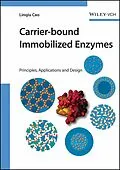Carrier-bound Immobilized Enzymes
The first systematic overview of this key technique since the early 1990s, this authoritative reference is the only handbook available to include all recent developments. The author draws on his wide-ranging experience in both academia and industry to systematically cover all types of enzyme immobilization methods, including such novel techniques as site-specific immobilization, imprinting and immobilization in organic solvents.
From the contents:
- Introduction to Immobilized Enzymes
- Adsorption-based Immobilization
- Covalent Enzyme Immobilization
- Enzyme Entrapment
- Enzyme Encapsulation
- Unconventional Enzyme Immobilization
Throughout, a careful review of materials and techniques for the preparation of functional immobilized enzymes that benefits both developers and users of carrier-bound enzymes. Essential reading for biotechnologists, chemists and food scientists using enzymes in their daily work.
Autorentext
Linqiu Cao studied Organic Chemistry and Biotechnology at the Beijing University of Science and Technology (China). He was a visiting scientist at GBF (Gesellschaft fur Biotechnologische Forschung) in Braunschweig (Germany) and later moved to the University of Stuttgart (Germany) to obtain a PhD in Biotechnology. He then joined the group of Roger Sheldon at the Technical University in Delft (The Netherlands), where he pioneered a novel enzyme immobilisation technology with improved performance in biocatalytic transformations using cross-linked enzyme aggregates (CLEAs). In 2000, he joined the newly founded company Avantium in Amsterdam (The Netherlands) where he continued to develop novel enzyme crosslinking and immobilisation technology. Recently he moved to DMV in Veghel (The Netherlands).
Klappentext
The first systematic overview of this key technique since the early 1990s, this authoritative reference is the only handbook available to include all recent developments. The author draws on his wide-ranging experience in both academia and industry to systematically cover all types of enzyme immobilization methods, including such novel techniques as site-specific immobilization, imprinting and immobilization in organic solvents.
From the contents:
- Introduction to Immobilized Enzymes
- Adsorption-based Immobilization
- Covalent Enzyme Immobilization
- Enzyme Entrapment
- Enzyme Encapsulation
- Unconventional Enzyme Immobilization
Throughout, a careful review of materials and techniques for the preparation of functional immobilized enzymes that benefits both developers and users of carrier-bound enzymes. Essential reading for biotechnologists, chemists and food scientists using enzymes in their daily work.
Inhalt
Foreword v
1 Introduction: Immobilized Enzymes: Past, Present and Prospects 1
1.1 Introduction 1
1.2 The Past 4
1.2.1 The Early Days (19161940s) 5
1.2.2 The Underdeveloped Phase (1950s) 5
1.2.3 The Developing Phase (1960s) 7
1.2.4 The Developed Phase (1970s) 9
1.2.5 The Post-developed Phase (1980s) 14
1.2.6 Rational Design of Immobilized Enzymes (1990sdate) 16
1.3 Immobilized Enzymes: Implications from the Past 20
1.3.1 Methods of Immobilization 20
1.3.2 Diversity versus Versatility 21
1.3.3 Complimentary versus Alternative 23
1.3.4 Modification versus Immobilization 25
1.3.4.1 Enhanced Stability 25
1.3.4.2 Enhanced Activity 26
1.3.4.3 Improved Selectivity 29
1.4 Prospective and Future Development 34
1.4.1 The Room for Further Development 34
1.4.2 An Integration Approach 36
1.5 References 37
2 Adsorption-based Immobilization 53
2.1 Introduction 53
2.2 Classification of Adsorption 54
2.3 Principles Involved in Absorptive Enzyme Immobilization 55
2.3.1 Monolayer Principle 56
2.3.2 Stabilization Principle 57
2.3.3 Enzyme Distribution 60
2.4 Requirement of the Carriers 61
2.4.1 Physical Requirements 61
2.4.1.1 Pore-size and Available Surface 61
2.4.1.2 Internal Structure 63
2.4.1.3 Density of Binding Functionality 63
2.4.1.4 Particle Size 64
2.4.2 Chemical Nature of the Carriers 65
2.4.2.1 Nature of Binding Functionality 65
2.4.2.2 The Role of the Spacer 66
2.4.2.3 The Nature of the Backbone 66
2.5 Factors Which Dictate Enzyme Catalytic Performance 67
2.5.1 Activity 67
2.5.1.1 Diffusion-controlled Activity 67
2.5.1.2 Conformation-controlled Activity 68
2.5.1.3 Substrate-controlled Activity 70
2.5.1.4 Loading-controlled Activity 70
2.5.1.5 Medium-dependent Activity 72
2.5.1.6 Microenvironment-dependent Activity 73
2.5.1.7 Carrier Nature-dependent Activity 74
2.5.1.8 Enzyme Nature-dependent Activity 75
2.5.1.9 Additive-dependent Activity 75
2.5.1.10 Hydrophilicity-dependent Activity 76
2.5.1.11 Orientation-determined Activity 78
2.5.1.12 Binding Nature-controlled Enzyme Activity 78
2.5.1.13 Binding Density-controlled Enzyme Activity 80
2.5.1.14 Reactor-dependent Activity 81
2.5.1.15 Pore-size-dependent Activity 82
2.5.1.16 Water-activity-dependent Activity 82
2.5.2 Stability 83
2.5.2.1 Conformation-controlled Stability 84
2.5.2.2 Confinement-controlled Stability 85
2.5.2.3 Enzyme Loading-dependent Stability 85
2.5.2.4 Diffusion-controlled Stability 86
2.5.2.5 Cross-linking-dependent Stability 86
2.5.2.6 Carrier Nature-controlled Stability 86
2.5.2.7 Aquaphilicity-controlled Stability 87
2.5.2.8 Medium-controlled Stability 88
2.5.2.9 Temperature-dependent Stability 88
2.5.2.10 Microenvironment-controlled Stability 89
2.5.2.11 Binding Nature-controlled Enzyme Stability 90
2.5.2.12 Binding Density-controlled Enzyme Stability 91
2.5.2.13 Additive-dependent Stability 91
2.5.2.14 Enzyme Orientation-dependent Stability 91
2.5.2.15 Enzyme-dependent Stability 91
2.5.3 Selectivity 92
2.5.3.1 Conformation-controlled Selectivity 93
2.5.3.2 Diffusion-controlled Selectivity 94
2.5.3.3 Binding Functionality-controlled Selectivity 94
2.5.3.4 Additive-controlled Selectivity 95
2.5.3.5 Orientation-controlled Selectivity 96
2.5.3.6 Medium-controlled Enantioselectivity 96
2.5.3.7 Water Activity-controlled Enantioselectivity 97
2.6 Preparation of Immobilized Enzymes by Adsorption 97
2.6.1 Conventional Adsorption 97
2.6.1.1 Non-specific ...
